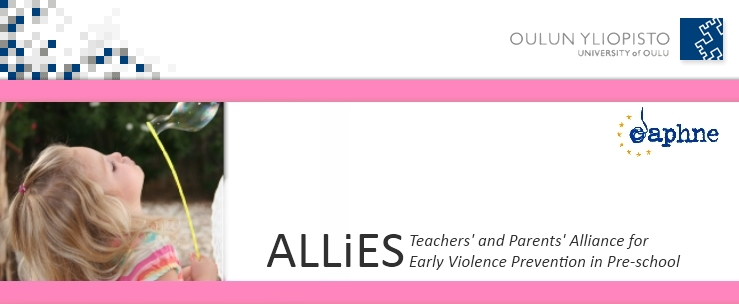
Questionnaires - Smiley
A tool for teacher’s to screen children’s emotions and
safety The teacher’s tool is named Smiley and
three different versions have been created during the project:
an electronic, poster and paper versions. An idea of the smiley
is to map child’s emotions in preschool, at home and in an
electronic version also on the way to preschool. Regular
charting of children’s emotions enables an early intervention if
needed, and also helps in emotional education when the children
learn to recognize their emotions.
Overall benefits of Smiley
- When the teacher is aware of children’s
emotions, it enables early intervention in bullying or other
violence. If some child is continually choosing an emotion
of fear or sadness in relation to a certain environment, the
teacher can discuss the issue with the child and evaluate
the need for cooperation with the child’s parents.
- The Smiley tool also helps children to
recognize and talk about feelings.
- The results of Smiley can be used in
discussions with parents about child’s wellbeing
- Children might have questions about
emotions lacking in this tool. These are good discussion
openers to broaden the awareness and meanings of different
feelings together with the class.
- Children will learn how to deal with
different feelings. For example, if the icon “being afraid”
is often chosen by someone, it is crucial to explore what
causes the fear and whether there is some emotional need
behind the feeling that should be satisfied (e.g. a need for
security or a need for respect). It can then be discussed
what could be done to change the child’s experience of
emotion in a more positive direction.
The Smiley screening tool has three
different versions:
 Individual
Paper Smiley Individual
Paper Smiley
Every child has her/his own Smiley paper for
each week to be filed twice every day in a personal folder. The
child can make an entry about her/his feelings in the morning
when arriving (reflections related to home and/or the trip to
daycare/school) and also in the afternoon when leaving
(reflections related to daycare/school). The children’s answers
are checked regularly and possibly discussed with the child in
question and, if necessary, with the child’s parents as well.
Benefits
- Individual paper version is usually more
suitable for daily use with small children than the
electronic version, due to limited access to computers and
mobile phones of children in this age group..
- Individual paper version gives more
intimacy for children to use Smiley individually if for
instance all children do not want to show their answers to
everybody.
- Compared with e-version, the paper
version can be evaluated every day if needed. This is
important, because small children rarely remember what has
happened a couple of days ago.
Challenges: It is important to consider over
how long the observation period will take place so that the
children do not get bored with the smiley and that the teacher
remembers to evaluate each child‘s paper regularly.
 Poster
Smiley Poster
Smiley
Poster Smiley is a paper sheet on the class
wall where every child has her/his name and records her/his
feelings on a daily basis with smileys of different feelings
such as happy, sad, calm, or scared or angry. The poster is
recommended to be filled in in the morning and before leaving
school.
Benefits:
- The poster is easy to fill in and always
available.
- Filling in the poster smiley can provide
an opportunity to launch a discussion on feelings.
- It can be also used directly by the
teacher in the classroom when the child expresses her/his
mood.
- Teachers can easily collect data about
each child's choices.
Challenges:
- Everybody can see each other‘s feelings
and it needs to be noted that some children do not want to
show their real feelings to everybody by filling in the
Smiley poster.
- It was also noted that some children,
most often some boys, want to get respect or status by
drawing e.g. an angry face even if it is not their true
feeling but a part of constructing agency considered
masculine.
| Paper and a
poster version |
 Electronic
Smiley Electronic
Smiley
The idea in e-Smiley is that the child
chooses prevalent emotions related to home, daycare/school and
the school trip by clicking the figure illustrating her/his
feeling in those contexts. The information is sent
electronically to the teacher or daycare worker who checks the
children’s answers once a week and intervenes if there is cause
for concern with some of the children. E-Smiley should be used
regularly, for example once a week over a longer period.
Benefits:
- Electronic format motivates children to
answer.
- The data is in electronic form and is
easily available and analysed as well as stored.
- This form can be used also in mobile
phones.
- E-Smiley can be filled also at home with
parents.
Challenges:
- Difficult to use on daily basis due to
limited access to computers.
- It is challenging to organise the
filling of e-Smiley as part of daily routine.
- The collecting of the data has to be
adapted in each school’s database, or more funding is needed
to develop this system so that it could be easily adapted to
shared database.
E-smiley was piloted
during
Allies-project.
|
 Home Home
Structures
Parent-School
Child
Group
Q's
Q's
 Cuddle Cuddle
Smiley
Healthcare Checklist
Smiley (pdf)
 Paper/poster
smiley Paper/poster
smiley
Smiley
instructions
Experiences
of Smiley
|


